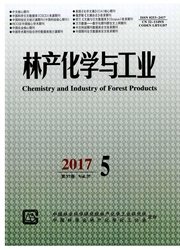

 中文摘要:
中文摘要:
采用水热合成法制得BO3^3-/ZrO2/Mo-MCM-41中孔分子筛。用XRD、N2吸附脱附、FT-IR及氨气程序升温脱附(NH3-TPD)等技术对其结构及酸强度进行了表征。结果显示,该中孔分子筛具有典型的中孔结构、良好的长程有序性和结晶度;BO3^3-和ZrO2的引入既增加了Mo-MCM-41中孔分子筛酸中心数量,又提高了其酸强度。在超临界CO2条件下,将此酸性中孔分子筛用于催化松香聚合反应。BO3^3-/ZrO2/Mo-MCM-41中孔分子筛显示出较高的催化活性,制得软化点为106℃的聚合松香,达到国家行业标准ZBB72008-1989规定的115号聚合松香产品质量标准。对BO3^3-/ZrO2/Mo-MCM-41的寿命进行了考察,并研究了催化剂失活的原因。
 英文摘要:
英文摘要:
Mo-MCM-41 molecular sieve was prepared by hydrothermal synthesis method, and BO3^-3-/ZrO2/Mo-MCM-41 molecusieve was prepared by impregnating Mo-MCM-41 successively with H3BO3 and Zr( SO4 )2 solutions. BO3^3-/ZrO2/Mo-MCM-41 molecular sieve was characterized by XRD, N2/adsorption-desorption, FT-IR and NH3-TPD measurement. The results show that the molecular sieve obtained possesses the characteristics of mesopores, good long-range order and crystallinity, and that BO3^3- and ZrO2 are combined with the framework of the molecular sieve so that its acidity is improved. To find out a new method for synthesize polymerized rosin to replace the conventional methods using sulfuric acid as catalyst that exists serious disadvantages, the mesoporous molecular sieve was firstly used under supercritical CO2 condition. It was shown in the reaction that the supercritical C02 fluid was favorable to the synthesis of polymerized rosin, and that BO3^3-/ZrO2/Mo-MCM-41 molecular sieve exhibited good catalytic activity. Under supercritical carbon dioxide conditions, the product which showed a softening point of 106℃ was obtained by using BO3^3-/ZrO2/Mo-MCM-41 mesoporous molecular sieves as catalyst. The reason for decrease of catalyst activity was studied by FT-IR measurement. It is the main factors leading to decrease of catalyst activity that acidity center of catalyst was lost after catalyst was used.
 同期刊论文项目
同期刊论文项目
 同项目期刊论文
同项目期刊论文
 期刊信息
期刊信息
